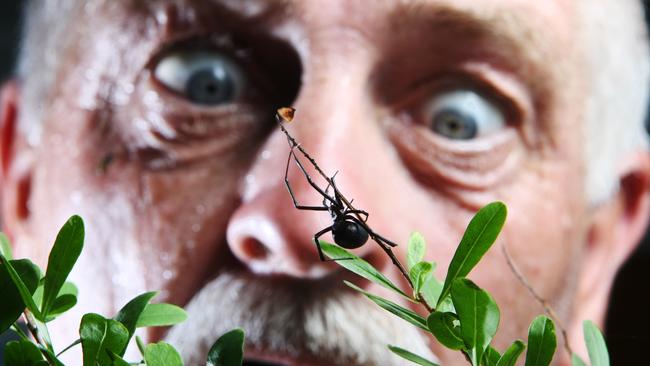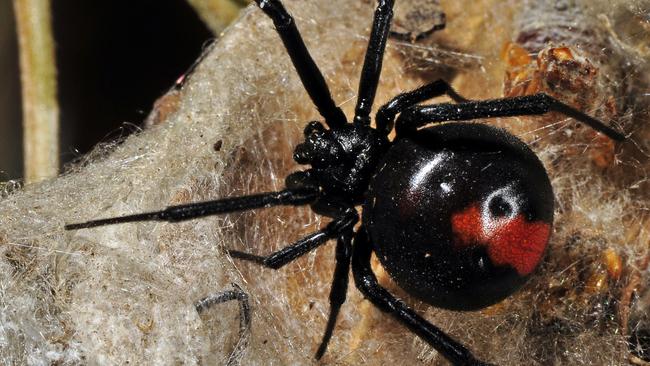Way We Were: Queensland’s bizarre history of redback spider bite treatments
Brandy, vinegar, tobacco juice or slicing open flesh — Queenslanders bitten by the feared redback relied on wild remedies in the hope of dodging almost certain death, writes Dot Whittington.
QLD News
Don't miss out on the headlines from QLD News. Followed categories will be added to My News.
Today it’s the web but for the first 100 years, Queenslanders talked about the spider, in particular the little black brute with a red spot on its back.
Although its toll wasn’t as high as the funnel webs that were the scourge of the south, the little redback packed a punch right around the state.
There were regular reports of bite victims from all over Queensland – some survived and some didn’t – but all were in excruciating pain, often for days.
In 1893, the manager of the Warwick Gasworks was bitten by the “well-known black insect, with a red mark on the back” and it was feared it would have been fatal if not for quick medical aid.

A sexton in Toowoomba wasn’t so lucky. After being bitten by a black and red spider in 1903, he spent days in hospital before succumbing to the virulent poison.
At Stonehenge south of Longreach, a two-year-old girl died after being ill for several days.
There was a mark on her wrist where she had been bitten.
A 10-year-old Toowoomba boy bitten while peeling bark from a tree died in hospital. His doctor said redback poison was the direct cause of death.
An inquest in Mackay found a four-year-old boy had died from a spider bite, as did a policeman at Drayton who was bitten in the groin.
Newspaper correspondents were eager to share their cures.
In 1897, permanganate potash was proposed as being splendid.
“One gentleman of our acquaintance makes it a practice of always having a few grains of permanganate handy, and thanks to this precaution was able to get over a rather nasty bite from a black spider,” he wrote.
“The gentleman in question was hunting for his horse through the bush, when one of these red-backed individuals fastened on to his neck, below the ear, and bit him. Our friend felt the prick and soon discovered the spider.
“Putting a few grains of permanganate into a glass with a few drops of water, he got a friend to rub the solution well in, and though the injured part began to swell and throb for a time, there were no after ill effects, and by next morning the cure was complete.”

Potassium permanganate was first developed as a disinfectant in 1857 and is still on the World Health Organisation’s list of essential medicines. Another correspondent suggested a simple and perfect cure nearly always at hand – the tobacco juice which accumulates in the ordinary smoking pipe.
If laid on the bitten part without delay, pain ceases instantly and no bad effects follow.
When the 9-year-old daughter of James Green of Bainbilla, south of Roma, was in agony after being bitten on the neck by a redback in 1905, her father remembered reading of a vinegar cure for snake bite.
He rubbed vinegar in the bite for about half an hour. At first she worsened, but then the vinegar gained on the poison and she went to sleep, helped by a dose of schnapps. By morning she was none the worse for her experience.
Onions were another favourite.
A road worker bitten by a redback near Cairns in 1908, had a poultice of crushed raw onion applied to the wound. Three hours later, he was free from pain and, after a good sleep, felt no ill-effects.
This cure was again suggested in Warwick in 1937: “An onion should be sliced and the raw moist edge applied to the bite and fresh pieces of onion applied frequently. The onion acts as a poultice and draws the poison from the bite – a simple treatment, but most effective.”
In 1937, Mr Cook, assistant superintendent at the Lockhart River Mission, narrowly escaped death when “a few natives at the station applied their primitive methods to his wounds and saved him.”
The spiders had crawled into his boots. He was quickly paralysed in the arms and legs, and only able to mutter “red-backed spider” when assistance arrived.
“They threw hot water over his body and placed him on his bed and one of their women, smashing a bottle, cut his body with the razor edges of glass, and left the wounds to drain, so that the poison could get away.
“For three or four days he continued in a dangerous condition, but the primitive treatment had its effect,” it was reported.
And finally, there was the old joke about the ship’s captain who was told to give a crew member bitten by a spider a stiff dose of brandy every two hours.
He reported that the patient was cured but other crew members were complaining of a spider bite.




